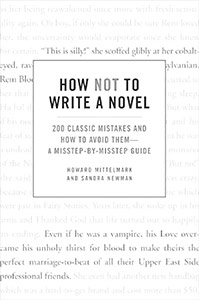Reading Between The Lines: Writing for readability

Having dreams and aspirations is important. It's just that when those dreams and aspirations tend to fall on the creative and artistic side of things is when the flow of jumbled, messy ideas should be stemmed in favour of organizing thoughts and ideas, translating them into a format that's comprehensible at the very least. How Not to Write a Novel, written by authors and book editors Howard Mittlemark and Sandra Newman, is intended to be the dam that stops the gushing babble of your pen on paper.
Yep, we've come in full circle here, reviewing a book that's about writing a book. But Novel isn't just a droning clinical analysis on the importance of structure and grammar in your writings. It gets straight to the point, that you're writing your book not just for the art, but because you actually want to get it published, and it addresses that fact with a charming, humourous sense of camaraderie. It tells you why your writing sucks, but lays it down gently on you, and even elicits more than a chuckle or two along the way.
How Not to Write a Novel covers all the aspect a large-scale story would have; an established cast of characters, a firm setting, and a definitive style of writing prose and dialogue, and so on. Rather than describe bad writing, Novel instead presents hilariously overthe- top samples from fake poorly written novels, and provides a breakdown of exactly what's wrong with them. It's not just effective as a means of natural teaching, but it's also the source of the book's humour, and is what makes the book entertaining and absorbing, rather than a chore of an instructional manual.
The analysis quizzes are not just entertaining, but important as an examination of your own creativity. In the fashion of a magazine quiz, choosing the most stereotypical answer to a question on tropes and literary devices lends you the lowest possible score with the urge to re-examine how you view people and accordingly, write them well in your own fiction. Novel is, by and large, about refining your creative process, but lectures on the importance of how many prepositions are needed to make your sentence comprehensible or even less so are there to remind you on the importance of grammar.
Of course, now that your perfectly written novel is ready to hit the presses... well, first you need to get the person who can make that possible make it so for you. In completeness, Novel also teaches how to pitch your work to a publisher. Resorting to over the top examples once again comes out in favour of teaching you the essentials. It's not just funny, but also teaches you how to appeal to the distinguished screening process of the literary agent's scan for bad apples. Resume writing it ain't.
How Not to Write a Book is casual in tone, but as a writing tool, couldn't be any more useful. It deserves a read before the start of any big writing project. Even the best of us can fall into the trappings of transparently awful characters and a criminally overdone usage words. No matter how talented of an (unpublished) author you may think you are, you might be guilty of some of the crimes against literature complied in this book. At the very least, you'll know what bad writing looks like without sacrificing your time reading terrible novels.
Reading Between The Lines explores books that you may have missed out on that are worth your while. If you have a book to suggest, email Eshaan at e_gupta@fanshaweonline.ca.













